Beak trimming is something you will almost never have to do. If you have a bird whose beak is growing fast there is a good chance that there is a health issue there. I believe its actually most times a liver disorder. Sometimes a bird’s beak if neglected can become curved beyond medical help. There is a cute bird named Pinocchio whose top beak is bent and deformed. He requires special food and feeding but he gets on just fine. Birds generally will have no issues with their beaks especially if you have enough shredding material for them to engage in. Different species have different beaks. Palm Cockatoos have very specialized beaks for cracking hard palm nuts open with 1500 lbs of pressure. They can’t even close their mouths all the way. Ekkies or Eclectus Parrots have very long beaks, the males even longer than the females but most parrots are hook bills. Cockatoos are a bit different but hook bills generally will have a crescent shaped beak with a sharp point. That point is sharp for the same reason our cutlery is. They use it to get at their food.
Birds will dig into food and if their beaky is wet they’ll look like they stuck their face in glue and rolled in seeds. They’ll clean it off by taking their beak and rubbing it on a pole, stick or dowel. They will do this when they bathe and take a drink too. This cleans it off but it also puts a sharp point on it for them. This is another good reason to have at least one sand perch because a rougher perch will help them clean their beaks off and help keep it sharp both at the tip for a sharp point but also the edges to crack into seeds and to help grind their food. If you use Roudybush like we do, you’ll notice that the Crumble pellets turn into almost a crumbled dust. They basically take the pellet into their mouth and like a chef with a sharp knife on a celery stalk they grind/chop paper thin layers off into their mouths as they push the piece through their beak shaped cutting board.
Most of the time, birds will keep their beak pretty clean by themselves but sometimes food will become impacted in their upper beak. They loosen this with water just like we do with milk when we eat cookies. This is also another reason why having the water silo set up this way is beneficial because the angle they have to drink at helps them cleanse their beak.
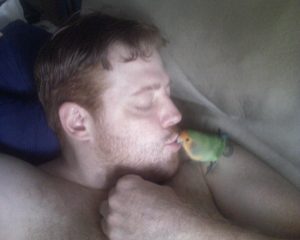 So the moral of this story is that for the most part you won’t have to worry about a bird’s beaky. But if you do need to “take the edge off” so to speak, i.e. make that really sharp point on their beak a bit less sharp, hold the bird like you normally would. Reach around with your thumb and index finger and grab in a pinching type motion either side of the BASE of the top beak. The reason you do this is the same reason you use a vice to hold a piece of wood you’re sanding. If you don’t and start filing away, you could stretch the bird’s beak right out of its socket. Remember, birds are tiny and frail compared to us large humans. Especially lovebirds.
So the moral of this story is that for the most part you won’t have to worry about a bird’s beaky. But if you do need to “take the edge off” so to speak, i.e. make that really sharp point on their beak a bit less sharp, hold the bird like you normally would. Reach around with your thumb and index finger and grab in a pinching type motion either side of the BASE of the top beak. The reason you do this is the same reason you use a vice to hold a piece of wood you’re sanding. If you don’t and start filing away, you could stretch the bird’s beak right out of its socket. Remember, birds are tiny and frail compared to us large humans. Especially lovebirds.
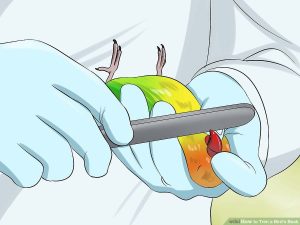 Assuming you’re simply trimming your bird’s beak for sharp point elimination vs. beak deformity/overgrowth, you want to make sure you hold your bird a certain way. This is because the scrawny stature of a bird’s neck won’t take the full brunt of your filing. This picture from Wikihow shows how you hold a bird and slowly move the file in one direction. This will cause the beak to vibrate and may startle or tickle the bird. You need to get your bird used to this. This is where trust comes in.
Assuming you’re simply trimming your bird’s beak for sharp point elimination vs. beak deformity/overgrowth, you want to make sure you hold your bird a certain way. This is because the scrawny stature of a bird’s neck won’t take the full brunt of your filing. This picture from Wikihow shows how you hold a bird and slowly move the file in one direction. This will cause the beak to vibrate and may startle or tickle the bird. You need to get your bird used to this. This is where trust comes in.
I prefer to hold the beak on both sides. Otherwise you get the beak bend which puts stress on the neck if you don’t secure all the way down to the tip of the beak. Your bird is trusting you not to hurt him. Your bird’s beak shouldn’t bend or move like the earplug below. The smaller your hands, the more difficult this may be to do so if you can’t then see your vet. But if you if its just to dull the sharp point, use my method.
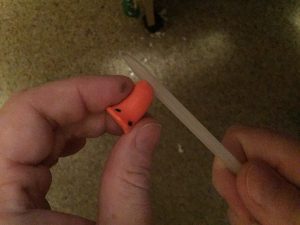
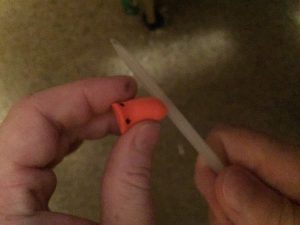
So grab the beak at the base with your first knuckles and close your fingertips together around the beak until the tips should be close to touching at the front of the beak. Take a fine grit nail file, preferable a glass one (I’d stay way from metal ones and emery board, coarse grit ones) and slowly file in short, smooth strokes. You only need to do about 4 strokes. Test to make sure by poking your index fingertip to see if its still sharp. If so, you’re done. If not, repeat with 4 strokes until it no longer feels uncomfortable to prick your finger.
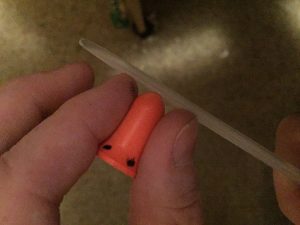 Too much filing and your bird could have trouble getting at or open his food. The ONLY reason you’d even file their beaky is if they like giving you birdie kisses (which if your bird trusts you they will) and their beak is sharp. So if they’re either giving the kisses or trying to get your attention for them, a sharp beak can hurt. Not really hurt necessarily but more of a slightly painful annoyance that you’d rather not have, especially for such a joyous event as birdie kisses.
Too much filing and your bird could have trouble getting at or open his food. The ONLY reason you’d even file their beaky is if they like giving you birdie kisses (which if your bird trusts you they will) and their beak is sharp. So if they’re either giving the kisses or trying to get your attention for them, a sharp beak can hurt. Not really hurt necessarily but more of a slightly painful annoyance that you’d rather not have, especially for such a joyous event as birdie kisses.
If your bird has an overgrown beak and you got him that way you really need to take him to a vet and get the beak trimmed properly. Sometimes, they cannot do anything because it is so bad. A bird’s beak will generally not have any anomalies except for 3 main reasons;
1. Genetic defect: This you can’t really do anything about. This is just bad genes or an accident when the bird is very young and the beak does not form properly. This usually won’t happen when birds are raising their own young. They will literally toss these babies aside to die. That’s just nature. This type of deformity will usually only be expressed in adulthood when humans decide to try to help the bird live. Many birds online have beak deformities and get along just fine although some would simply perish without human intervention. But these are generally chosen deformities.
2. Neglect: This is when the bird has no way to trim their beak. This is the main cause of beak elongation which will lead to deformity. Due to neglect, if you decide to home a bird with these attributes, money, care and patience will be needed.
3. Disease: Many times (this isn’t gospel, just observation) this is a liver disorder. If your bird has a beak that just seems to grow way faster or to a shape that doesn’t look like all the other birds you see online of the same breed, make sure you get them to a vet.
As stated before, birds being an inexpensive, ergo an “expendable” pet, WILL win your heart. So be prepared when these types of unforeseen issues come up so you don’t lose the best friend you never expected.
